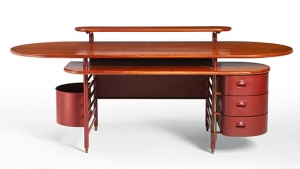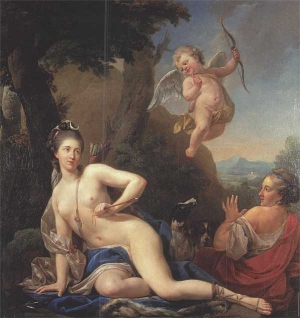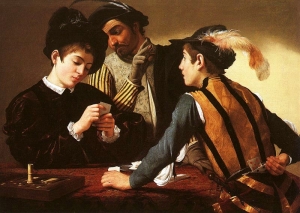|
Displaying items by tag: Sued
A bitter dispute over a painting bought for £140 five decades ago reaches the High Court today – with some of the world’s most prominent Caravaggio experts lining up to take sides.
Sotheby’s is being sued over claims that it misattributed a work – The Cardsharps – to a follower of Caravaggio rather than the Italian painter himself, costing the seller millions of pounds.
The president of the World Jewish Congress, Ronald Lauder, urged a leading Spanish museum to return a painting that the Nazis stole from a Jewish art collector.
Lauder, in a statement issued on Friday, called on the Thyssen-Bornemisza Museum in Madrid, which is owned by the Spanish state, to stop its legal fight to keep the Impressionist masterpiece “Rue Saint-Honoré, après-midi, effet de pluie,” which the Nazis stole from Lilly Cassirer, a German Jew seeking to flee her homeland in 1939.
The painting was purchased from the painter Camille Pissarro by Lilly Cassirer’s father-in-law, Julius. Her late grandson, Claude, sued for restitution in 2005 in a claim he filed with the United States District Court for the Central District of California.
One of the most glamorous figures in the London art scene is the subject of a £3 million High Court writ over allegations that she purchased two contemporary works for a client who was unable to pay for them.
Olyvia Kwok successfully bid for "Water-Worshipper" by Jean-Michel Basquiat and "Idilli" by Cy Twombly at Sotheby’s.
Miss Kwok runs an art and jewels investment firm for clients “who tend to be individuals or families with a net worth in excess of $30 million” and made her bids at the sale in February.
Troubled Manhattan art dealer Helly Nahmad, who was thrown in prison in April for running an illegal gambling ring, is being sued for allegedly hiding a $20 million painting stolen by the Nazis.
Frenchman Phillippe Maestracci, whose grandfather Oscar Stettiner was a Jewish art dealer when he fled Paris before Hitler’s army invaded in 1939, is suing Nahmad and his billionaire art dealer dad David Nahmad in Manhattan Supreme Court.

S.C. Johnson & Son, a global manufacturer of household cleaning supplies and other consumer chemicals, has filed a lawsuit against Sotheby’s. The lawsuit concerns a rare desk and chair from the Frank Lloyd Wright-designed S.C. Johnson & Son Administration Building in Racine, Wisconsin. The furniture, which was slated to be the highlight of the auction house’s upcoming 20th century design sale on December 18, exemplifies American Modernism.
According to a complaint filed in a New York federal court, S.C. Johnson claims that that the desk and chair are stolen goods. While the company does loan furniture and objects designed by Wright to museums, selling works is against their policy. The company’s statement went on to say that the removal of the desk and chair from the Administration Building was not authorized.
The sale’s catalogue lists the provenance of the desk as having been acquired by the chemist Elerslie E. Luther from S.C. Johnson during the early 1950s. The desk was alleged passed on by descent until it reached the current owner who acquired it from Jeffrey V. Luther. However, there is no evidence of a connection between Luther and S.C. Johnson in the company’s records. Similarly, the catalogue lists the chair as having been gifted by Samuel C. Johnson to a private collector in 1972. However, the bequest in inconsistent with S.C. Johnson’s records.
The desk is estimated to sell for $400,000 to $600,000 while the chair is expected to net $80,000 to $120,000.

In November 2012, two members of the Metropolitan Museum of Art in New York sued the institution for making the public think that the suggested admission fees are mandatory. The historically free institution suggests entry fees of $25 for adults and less for seniors and students.
Theodore Grunewald and Patricia Nicholson filed the suit in state court in Manhattan and said that the museum’s fee policy lacks transparency. They also argued that the museum fails to note that the fee is suggested on several of its websites and that it’s only in fine and barely legible print on signs near cash registers. A statute was put in place in 1893 declaring that the Met must remain free in order to continue receiving government funding. Grunewald and Nicholson commissioned a survey of visitors to the museum and found that 85% of patrons believed they had to pay to gain entry.
According to court papers filed by Gerald Lee Jones, who worked at the Met as a floor manager from 2007 until 2011, cashiers were paid in part based on how much they collected from admission fees. The statement, which was filed in late June 2013, also suggested that cashiers were instructed to never volunteer that patrons may pay less than the “recommended” fee.
Harold Holzer, the Met’s senior vice president for public affairs, said that Jones, “one of the many floor managers” had a “glib spin on his experience [at the museum].” Holzer also asserted that the Met tracks how much the cashiers collect because auditors require admission figures. “It has nothing to do with performance evaluation or salary,” said Holzer, adding “The Met will offer its response in due course.”
During the year ending in June 2012, the Met brought in $37.8 million in admissions, about 16% of the museum’s revenue.

In November 2012, two members of the Metropolitan Museum of Art in New York sued the institution for deceiving the public by making patrons think that the suggested admission fees are mandatory. The historically free institution suggests entry fees of $25 for adults and less for seniors and students.
Theodore Grunewald and Patricia Nicholson files the suit in state court in Manhattan and said that the museum’s fee policy lacks transparency. They also argued that the museum fails to note that the fee is suggested on several of its websites and that it’s only in fine and barely legible print on signs near cash registers. A statute was put in place in 1893 declaring that the Met must remain free in order to continue receiving government funding. Grunewald and Nicholson commissioned a survey of visitors to the museum and found that 85% of patrons believed they had to pay to gain entry.
According to court papers filed by Gerald Lee Jones, who worked at the Met as a floor manager from 2007 until 2011, cashiers were trained to deceive visitors and they were paid in part based on how much they collected from admission fees. The statement, which was filed in late June 2013, also suggested that cashiers were instructed to never volunteer that patrons may pay less than the “recommended” fee.
During the year ending in June 2012, the Met brought in $37.8 million in admissions, about 16% of the museum’s revenue.

When Steven Brooks, a collector of Old Master paintings, purchased Louis-Michel van Loo’s Allegorical Portrait of a Lady as Diana Wounded by Cupid from Sotheby’s in 2004, he was unaware that the work was once owned by the German war criminal Hermann Goering. After it surfaced that Nazis possibly looted the work, Brooks deemed the painting worthless and decided to sue Sotheby’s for not thoroughly researching the work’s provenance.
The painting’s problematic past was revealed when Brooks tried to sell the painting at Christie’s in 2010. Specialists at the auction house discovered that Goering had purchased the painting in 1939, leading Christie’s to decline the offer to sell Portrait of a Lady on behalf of Brooks. Brooks’ lawsuit claims that Sotheby’s also refused to auction the work and won’t refund the nearly $90,000 he spent on the painting in 2004.
While there is no solid proof that the work was looted by Nazis, the uncertainty surrounding the painting makes it unsalable and in turn, monetarily worthless. Sotheby’s 2004 catalogue lacked any information on the painting between 1906 and 1987 and Christie’s was unable to determine anything other than the fact that Goering once owned the work. It is typical for private dealers to avoid works whose ownership cannot be traced between 1933, when the Nazis came to power, and 1945, when World War II ended, because of potentially problematic provenances.
There are currently no claimants for van Loo’s Allegorical Portrait of a Lady as Diana Wounded by Cupid.

In 2006 The Cardsharps was sold to the late collector and scholar Sir Denis Mahon for just over $65,000 at an auction at Sotheby’s in London. At the time of the sale, Sotheby’s identified the work as being by a “follower” of the Italian master, Caravaggio (1571-1610). However, after his purchase, Mahon identified the work as a Caravaggio original and obtained an export license for the work that put its value at $15.5 million according to a claim filed at London’s High Court of Justice.
Due to their failure to identify The Cardsharps as an authentic Caravaggio painting, Sotheby’s is being sued by Lancelot William Thwaytes, who consigned the work to the 2006 auction. Thwaytes is now seeking unspecified damages, interest, and costs relating to the price difference between the painting’s 2006 selling price and what he believes it was actually worth on the open market that year had it been properly attributed to Caravaggio. Thwaytes claims that Sotheby’s was negligent in its research prior to the work’s sale, leading to its extraordinarily low selling price.
However, Sotheby’s stands behind its belief that the painting is a copy and not a work by Caravaggio’s hand, citing Caravaggio expert Professor Richard Spear and several other leading scholars. Sotheby’s added that their view was supported by the market’s reception to the painting when it was put up for auction.
Mahon, who passed away in 2011, donated 58 works from his collection worth around $155 million to various U.K. galleries.

An elderly woman sued the Gagosian Gallery, claiming it allowed her son to sell a major work by pop artist Roy Lichtenstein, without her permission, for far less than its true value.
Ninety-three-year-old Jan Cowles sued Larry Gagosian and the Gagosian Gallery, in New York County Court.
She claims that her son Charles Cowles, an art dealer in New York City, sold her Lichtenstein enamel, "Girl in Mirror," out of financial desperation, while his mother suffered "moderate to severe dementia."
Charles Cowles is not a party to the case.
The complaint states: "By 2008, Charles Cowles suffered large financial losses and was in desperate financial condition. Charles's financial distress was known to Gagosian; and, in fact, the closing of Charles's gallery was reported in a large article in the 'New York Times' in June 2009, which refers to Charles Cowles Gallery as the 'most recent casualty' in the contemporary art market, and quotes Charles as commenting that '[i]t's shocking how bad business has been.'
"Unknown to Mrs. Cowles, by 2008 Charles had sold some of her art collection without her knowledge or consent and failed to remit the sale proceeds to her."
Jan Cowles says that her attorney-in-fact Lester Marks discovered what her son was doing in December 2009, and immediately hired counsel to investigate it.
"The investigation revealed two transactions between Charles and Gagosian regarding two major works of art: one involving a painting by Mark Tansey, and the other concerning the Lichtenstein work."
The Tansey work, "The Innocent Eye Test," was the subject of a similar lawsuit that Jan Cowles filed in May 2011.
Her new lawsuit, filed Wednesday, details the alleged fraud involving the $5 million Lichtenstein work at greater length.
"In or about October 2008, Gagosian somehow learned that Mrs. Cowles owned the Lichtenstein work," the complaint states. "Rather than contacting Mrs. Cowles directly, however, Gagosian chose to contact Charles Cowles to inquire as to whether Mrs. Cowles would consider selling it. Thereafter, Charles took Larry Gagosian to Mrs. Cowles's apartment at a time when she was not present to view the work. Upon closely inspecting the work (which hung prominently in the apartment) and without expressing any undue concern about its condition, Larry Gagosian represented that he could achieve a sale price of $3 million or more. In fact, Gagosian was aware, another 'Girl in Mirror' in the edition of eight had been sold almost a year and a half earlier, in May 2007, at an auction in Sotheby's for $4,072,000."
|
|
|
|
|